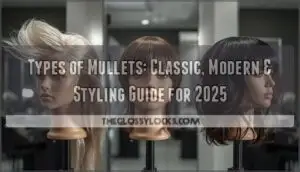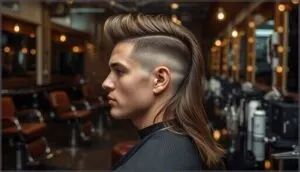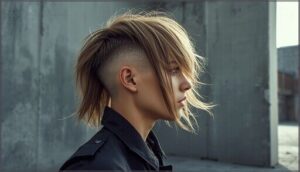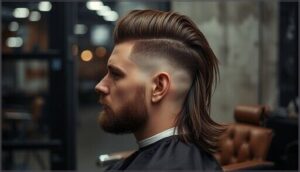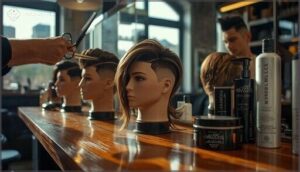This site is supported by our readers. We may earn a commission, at no cost to you, if you purchase through links.
TikTok’s mullet hashtag just hit 17.4 billion views, and salon chairs across the country are filling up with clients asking for this once-controversial cut. What started as a practical battle strategy in ancient civilizations became the defining look of ’80s rock stars, disappeared into cultural obscurity, and now stands as one of the most requested styles of 2025.
The modern mullet isn’t your dad’s party-in-the-back situation anymore. Today’s versions range from sharp fades with textured tops to soft, face-framing shags that blur traditional style boundaries.
Whether you’re drawn to bold retro volume or subtle tapered blends, understanding the full spectrum of mullet variations helps you find the perfect match for your hair type, face shape, and personal edge.
Table Of Contents
Key Takeaways
- The mullet has evolved from its 1980s rock star roots into a versatile 2025 trend with modern variations like fades, undercuts, and shag-mullet hybrids that work across all hair types and face shapes.
- TikTok’s massive 17.4 billion views on the mullet hashtag and celebrity influence drove a 30% spike in salon requests, transforming the cut from cultural punchline to gender-neutral self-expression statement.
- Choosing the right mullet requires matching the style to your face shape (oval faces suit most types, round faces need height, square faces work with softer layers) and committing to maintenance every 4-6 weeks.
- Styling success depends on using the right products—sea salt spray for texture, pomades for definition, and curl-defining products for natural waves—along with regular trims to keep the contrast sharp.
What is a Mullet Haircut?
The mullet haircut has gone from 80s punchline to one of the most talked-about styles in 2025. If you’re wondering what makes this cut so distinctive—or why it’s suddenly everywhere again—you’re in the right place.
Let’s break down what defines a mullet, where it came from, and why it’s having such a major comeback right now.
Defining Features of The Mullet
The mullet haircut thrives on contrast—short hair up front and on the sides, with noticeably longer locks flowing in back. This “business in the front, party in the back” style gives you bold versatility through:
- Hair length variation from closely cropped sides to neck-length or longer back sections
- Style contrast balancing professional front styling with relaxed, flowing texture behind
- Texture variety working beautifully with straight, wavy, or curly hair
- Adaptability through modern features like fades, undercuts, and layered transitions
You’ll find mullet hairstyles easily cultural phenomenon to match your personal edge.
The style became widespread in the 1980s.
Origins and Historical Popularity
Long before David Bowie rocked one, ancient civilizations figured out this haircut. Greek warriors and Roman soldiers wore short-front, long-back styles for battle practicality. Celtic fighters used it as intimidation, while indigenous tribes added spiritual symbolism.
The 20th-century surge came through 1970s rock icons, then exploded into the mainstream in the 1980s, with Billy Ray Cyrus leading the charge. The term “mullet” itself didn’t stick until the Beastie Boys’ 1994 song “Mullet Head.” The style has seen a non-gendered resurgence in recent years.
| Era | Cultural Impact |
|---|---|
| Ancient Times | Warriors used functional hair design |
| 1970s | Rock musicians revived the style |
| 1980s | Peak mainstream popularity worldwide |
| 1990s-2000s | Fell into ironic, meme territory |
| 2020s | Gen Z brought it back strong |
Mullet Appeal and Modern Resurgence
After decades as a punchline, the mullet roared back in 2024-2025 thanks to social media and celebrity influence. TikTok’s #mullet tag hit 17.4 billion views by May 2025, while stars like Paul Mescal and Harry Styles sparked a 30% salon request spike.
After decades as a punchline, the mullet roared back in 2024-2025 through TikTok virality and celebrity influence, sparking a 30% spike in salon requests
Gen Z embraced the modern mullet as gender-neutral self-expression, and professional acceptance grew as workplaces relaxed grooming standards.
Product innovation followed demand.
Classic Types of Mullets
Before mullets got their modern makeover, they spent decades earning their iconic status with a few standout styles that defined entire eras. These classic versions are where the “business in the front, party in the back” motto really came to life.
Let’s look at the OG mullet styles that started it all.
Traditional Mullet
You’ve probably heard the phrase ‘business in the front, party in the back’—that’s your classic mullet haircut right there. This cultural rebellion symbol features short hair up front and sides, with considerably longer locks flowing in back.
The mullet length disparity can range from 3 to 12 inches, creating that unmistakable contrast. It’s the foundation of mullet style, requiring regular trims every 4–6 weeks to keep your look sharp.
80s Retro Mullet
If you’re craving that rock concert energy from the 1980s, the 80s retro mullet delivers bold volume, dramatic layers, and unapologetic attitude. This mullet haircut defined an era, blending rebellion with creative expression.
Here’s what makes this classic mullet style stand out:
- Glam rock mullet: Extra volume with bold highlights for stage-ready flair
- Rocker mullet: Spiked tips and edgy texture
- Shaggy bangs: Softer, laid-back layers
- Cultural perceptions: Symbol of individualism despite mixed reactions
- Maintenance: Requires regular trims and volumizing products
You’ll need texture powder and strong-hold spray to nail that iconic look.
Country Mullet
The country mullet brings working-class roots and rural demographics together in one iconic men’s hairstyle. You’ll spot this mullet haircut thriving across Southern regions, where it’s more than a haircut—it’s cultural symbolism tied to country music and rugged pride.
Modern interpretations keep the feathered, natural back while cleaning up the sides. Regional prevalence remains strong in Midwest and Southern barbershops, proving this mullet style isn’t going anywhere.
Modern Mullet Variations
Today’s mullet isn’t your dad’s party-in-the-back haircut. The modern take brings fresh attitude with cleaner lines, textured layers, and styling that feels more runway than retro.
Here are the contemporary mullet variations that are turning heads in 2025.
Modern Mullet
The modern mullet brings a fresh twist to the classic men’s hairstyle, blending sharp fades with textured tops and longer backs. This 2025 trend showcases gender neutrality and cultural impact across social media platforms.
You’ll want styling products like texture clay or sea salt spray to nail the contrast. It’s evolved beyond simple mullet haircut styles into a bold statement of individuality that works for various hair types.
Hipster Mullet
The Hipster Mullet brings artistic flair to your modern mullet haircut with textured layers and softer transitions. You’ll need styling products like EVO Beach Paste for that signature tousled finish.
Urban demographics—especially creative communities in cities like London and New York—have embraced this mens hairstyle for its unisex appeal.
Its cultural associations with individuality and economic impact on salon trends show this mullet variation isn’t going anywhere.
Cropped Mullet
Think of the Cropped Mullet as the minimalist’s answer to bold mullet hairstyles. This short mullet variation keeps your sides tight with a trimmed top and blunt fringe styling swept forward—perfect if you’re riding the trend resurgence but want easy maintenance tips.
Modern variations blend skin fades with controlled length in back, proving this haircut balances rebellious cultural impact with everyday wearability.
Shullet (Shag-Mullet Hybrid)
Want the edgy mullet hairstyle with shaggy texture? The Shullet (shag-mullet hybrid) delivers exactly that—blending disconnected layers and face-framing fringe for a softer, more adaptable look than stark traditional mullets. This modern mullet trend swept runways in 2024-2025, loved for its hair adaptability across curly and wavy textures.
Styling shullets requires:
- Texturizing sprays for tousled movement
- Trims every 4-6 weeks
- Curl-defining products for natural texture
- Volume mousses preventing flatness
Faded and Undercut Mullets
If you want a mullet that feels polished and contemporary, fades and undercuts are where the magic happens. These techniques clean up the sides and create sharp contrast with the longer back, giving you that structured edge without losing the rebellious vibe.
Let’s break down the most popular faded and undercut mullet styles you can rock in 2025.
Mullet Fade
With the right fade techniques, your mullet taper fade can go from ’80s throwback to fashionable style statement. The burst fade mullet adds circular definition around your ears, while undercut mullet variations keep sides sharp and clean.
You’ll need quality styling products—texturizers and light pomades work best—plus maintenance tips like biweekly trims to preserve that modern mullet edge and cultural impact.
Temple Fade Mullet
The temple fade mullet—sometimes called the Brooklyn fade—sharpens the sides with a precision taper while letting the back flow wild. This mullet hairstyle balances contrast beautifully, working with various face shapes from oval to square.
Adjust your fade height to flatter your features, then use texture-enhancing styling products like sea salt spray or matte clay.
Keep maintenance frequency tight: refresh every four to six weeks for that crisp mullet haircut edge.
Undercut Mullet
The undercut mullet cranks up the drama with buzz-tight sides and long, textured flow on top and back—defined contrast at its finest. This modern mullet hairstyle has serious demographic appeal, especially with Gen Z embracing its cultural impact through TikTok and K-pop influences.
- Sharp undercut sides meeting cascading length
- Blow-dried volume styled with texture clay
- Edgy pairing with stubble or bold facial hair
- Maintenance tips: refresh every 4-6 weeks
- Styling products like pomade for sleek finish
Tapered and Blended Mullet
If sharp undercuts feel too intense, the tapered and blended mullet offers smooth, gradual transitions from shorter sides into flowing length.
This modern mullet with taper fade works beautifully for round, oval, and square faces, combining a clean mullet fade with textured volume.
Style it with molding paste, refresh every 3-4 weeks, and customize with burst fade variations for that polished-meets-rebellious vibe.
Mullets for Different Hair Types
Your hair type plays a big role in how your mullet looks and feels. Whether you’ve got natural curls, pin-straight strands, or waves that need a little coaxing, there’s a mullet style that’ll work with what you’ve got.
Let’s look at how different textures can shape your cut and give you that standout style.
Curly Mullet
The curly mullet is your best friend if you’ve got natural texture to work with. This style pairs those gorgeous curls on top with shorter, tapered sides—think volume without the bulk.
You’ll need curl-defining gels and moisturizing shampoos to keep those ringlets bouncing. Growth timeframes run about 6-12 months for that full party-in-the-back length.
Hydration practices make or break this look.
Permed Mullet
Want that iconic 80s vibe with a modern twist? The permed mullet delivers textured, bouncy curls that cascade down your back—pure nostalgia meets current trends.
This style’s cultural impact spans decades, from rockstars to today’s Gen Z trendsetters embracing permed variations. You’ll love the styling options: low fades, bold color treatments, or mohawk-inspired edges.
Just remember, perm maintenance means sulfate-free shampoos and regular deep conditioning every 10-12 weeks to keep those curls thriving.
Tousled and Wavy Mullet
Looking for that effortlessly cool vibe? The tousled and wavy mullet brings soft, textured layers and natural wave definition that flow seamlessly from front to back.
This styling choice works beautifully on medium to thick hair, flattering diamond and heart face shapes while channeling today’s cultural impact of retro-meets-modern grooming.
Regular maintenance with curl-enhancing styling products keeps those waves looking fresh and dimensional.
Bleached and Colored Mullets
Want to make a statement? Bleached and colored mullets have exploded on TikTok, racking up billions of views as Gen Z embraces platinum, neon green, and pastel shades. This cultural impact stems from fashion-forward self-expression, though bleach damage remains a real concern.
You’ll need sulfate-free shampoos, deep conditioning treatments, and heat protectants to maintain vibrancy. Professional styling products and regular trims every 4-6 weeks keep your bold hairstyle looking sharp.
Choosing and Styling Your Mullet
Getting the right mullet isn’t just about choosing a style—it’s about making sure it works with your unique features and lifestyle. You’ll want to think about your face shape, find the products that keep your cut looking sharp, and know what maintenance you’re signing up for.
Let’s break down how to choose, style, and customize a mullet that actually flatters you.
Matching Mullets to Face Shape
Not every mullet works for every face, and that’s where smart styling comes in. Oval faces handle almost any mullet type with ease, while round faces benefit from height on top to elongate. Square faces need softer layers to balance angles, and heart faces shine with longer, shaggy styles that add volume at the back.
Hair texture matters too—fine hair needs layers for lift, while curly types require controlled length.
Styling Products for Mullets
The right products make all the difference. Sea salt spray adds texture without weight—62% of mullet wearers swear by it. Pomades and styling creams define the front, while texture powders boost volume at the roots.
For curly hair types, mousse controls frizz, while straight styles need lightweight pomades.
Market trends show a 40% shift toward flexible-hold products that keep movement intact.
Maintenance and Upkeep Tips
Regular trimming every 4-6 weeks keeps your mullet looking sharp and prevents split ends from creeping up. Barber visits maintain precision, but your daily haircare routine with quality styling products determines how your mullet actually performs between cuts.
Washing frequency matters too—2-3 times per week protects natural oils while keeping things fresh. Hydration methods like leave-in conditioners tame frizz, especially on those longer back sections.
Customizing Your Mullet Style
Beyond the basics, your mullet transforms through creative details. Custom fades, color accents, and textured cuts let you own this modern mullet completely. Tapered necklines replace that messy ’80s vibe with polish, while the right styling products bring out your hair’s natural personality.
Want to stand out? Consider these customization moves:
- Add hard parts or patterns shaved into faded sections for edge
- Experiment with highlights or bold streaks to heighten visual impact
- Match mullet types to your face shape—structured styles suit angular features, while layered cuts flatter rounder faces
Frequently Asked Questions (FAQs)
Can women pull off mullet hairstyles successfully?
Absolutely—women rock mullets with style. The soft, shaggy mullet and modern mullet blend feminine mullet appeal with subculture acceptance, while celebrity influence proves styling versatility breaks gender norms effortlessly.
How long does hair need to be?
Your hair should be at least 2-3 inches to start a mullet haircut. The back needs 4-7 inches for that classic contrast, while growth timeframe usually ranges from 6-18 months depending on your desired length.
Whats the cost of a professional mullet?
Professional mullet haircuts generally run $20 to $50, depending on your location and barber shop. In major cities, expect higher costs. Factor in barber tipping and styling add-ons for the full price.
Do mullets work for thinning or fine hair?
You’ll be absolutely shocked at how well mullets improve volume and shape for fine hair. Layered cuts add fullness, while longer front sections cleverly conceal thinning hairlines—just use volumizing mousse and get regular trims.
How often should I trim my mullet?
You should trim your mullet every four to six weeks to keep the sides sharp and the shape intact.
Those with fades may need touch-ups every two to four weeks for best maintenance.
Conclusion
Just as the mullet found its way from ancient battlefields to modern runways, your perfect cut exists somewhere in this spectrum—waiting to match your texture, lifestyle, and fearless sense of style.
The types of mullets available today give you freedom to experiment without sacrificing professionalism or edge.
Book that consultation, bring reference photos that speak to you, and trust your stylist to translate yesterday’s rebellion into tomorrow’s signature look.

